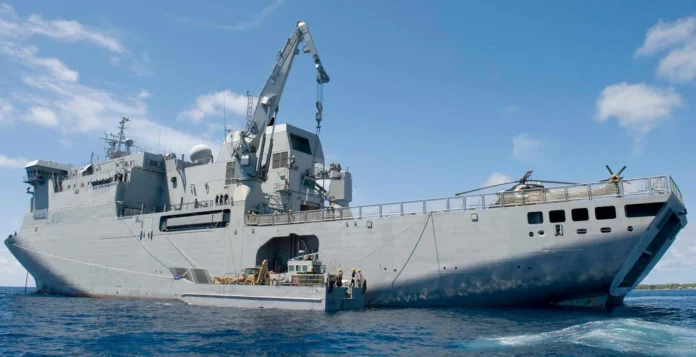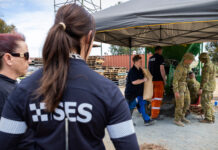
Ireland’s long-planned acquisition of a €300 million Multi-Role Vessel (MRV) has stalled as the Naval Service reportedly pushes for a more combat-capable design. The shift signals a move away from a humanitarian-aid-focused platform towards what is now called a Multi-Role Combat Vessel (MRCV), Navy Lookout reports.
Originally conceived as a multi-purpose platform for aid and peacekeeping operations, the MRV was to have been Ireland’s largest ever naval ship. It would have featured a flight deck for helicopters, vehicle storage with roll-on roll-off capability, limited hospital facilities and the ability to support overseas deployments or domestic disaster response. The ship was also intended to replace the ageing flagship LÉ Eithne, decommissioned in 2022, Despite years of discussion and market engagement, progress has been minimal.
Officers within the Defence Forces now believe the MRV concept would deliver limited operational value in an increasingly unstable security environment. Instead, there is growing advocacy for the MRCV, equipped for surveillance, deterrence, and limited warfighting, rather than simply logistics and aid. Equipped with 8 OPVs (of which typically only one or two are at sea), increasing Russian warship and submarine activity around the Irish coast has highlighted the Naval Service’s lack of ASW capability and growing concern about subsea infrastructure security.
A combat-capable ship would allow the navy to safeguard sea lines, potentially monitor activity around undersea cables, and contribute meaningfully to European maritime security. Such a platform could perform constabulary tasks while also providing credible self-defence and the ability to operate with NATO and EU partners. This shift would represent a subtle but significant change in posture. While Ireland remains militarily non-aligned, it increasingly participates in European defence initiatives and UN missions. Although rarely officially acknowledged, Ireland has often had to rely upon the RN or RAF to provide a visible deterrent to Russia.
The idea of Ireland fielding a warship could be controversial, potentially at odds with the nation’s traditionally neutral stance. The MRCV proposal would have to clear several approval gates before moving to tender, and any move to a combat vessel will require additional studies. Investment in port infrastructure will also be needed, particularly at Haulbowline Naval Base to accommodate a larger ship.
Among the concepts under informal consideration is the Arrowhead 140 or the Type 31 frigate derivative. Babcock already has a relationship with the Irish Naval Service, having delivered the four successful Samuel Beckett-class OPVs built at Appledore Shipyard and commissioned between 2014-19. AH140 offers flexibility that could appeal to Ireland’s requirements, being based on a proven hull form that can be configured for a variety of missions. Modular mission spaces, containerised systems, and the ability to scale its weapons fit according to budget make it a comparatively low-risk option. The platform’s British origin could also simplify logistics and training support.
The Type 31 displaces around 5,700 tonnes, considerably larger than anything the Irish Naval Service has ever operated. This would demand major investment in infrastructure and personnel, including the recruitment of highly skilled engineers and technicians. Lack of people could prove to be the biggest obstacle to progress as the Naval Service continues to face an acute personnel shortfall that underpins many of its wider capability problems. Chronic retention and recruitment difficulties have left the service operating well below its established strength, forcing several ships to remain alongside due to crew shortages. Experienced technical specialists and officers have been particularly hard to retain, attracted by better pay and conditions in the private maritime sector. Despite pay reviews and recruitment drives, numbers have yet to recover, and training pipelines remain under strain.
The acquisition of a frigate would represent the most ambitious expansion of naval capability in the state’s history. The shift from OPVs towards a genuine combatant would signal a long-overdue recognition that Ireland’s maritime interests can no longer be protected by constabulary means, reliance on allies or being seen as a ‘neutral state’. While neutrality remains central to Irish policy, this no longer means isolation. As European navies expand cooperation and the Atlantic becomes strategically contested, Ireland faces a choice: maintain a symbolic presence at sea, or invest in a vessel that could genuinely defend its interests.
For now, no final decision has been made, and all options remain under review, but the MRV platform is already viewed as a concept whose time has passed. Whether the project evolves into a lighter patrol-frigate derivative or even a Type 31 variant may determine the future character of Ireland’s naval service. From the UK perspective, any step to strengthen the Irish Navy would be broadly welcomed.


